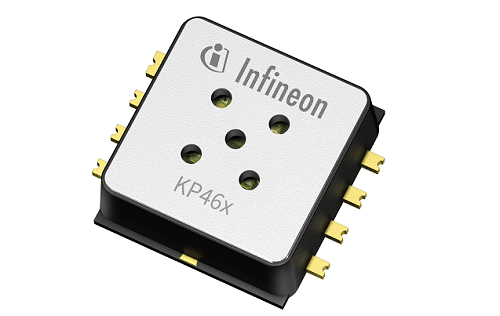The KP464 and KP466 sensors are high-performance, high-precision digital absolute pressure sensors based on the capacitive measurement principle.
The sensors provide automotive manufacturers with advanced solutions for engine control management and seat comfort functions.

Infineon Technologies has introduced two new XENSIV barometric air pressure (BAP) sensors, the KP464 and KP466, designed for automotive applications. The KP464 sensor is focused on engine control management, measuring atmospheric pressure to calculate air density and optimize the air-fuel mixture, leading to improved fuel efficiency and reduced power consumption. It combines density measurement with manifold air pressure monitoring, enabling lower power consumption and increased device productivity. On the other hand, the KP466 sensor is aimed at seat comfort functions, allowing for innovative pneumatic seat systems with features like multi-contour seating, adjustable lumbar support, massage functions, and driving dynamics adjustment. Both sensors are high-performance, high-precision, digital absolute pressure sensors with SPI interface, integrating temperature sensors and diagnostic functions. They meet automotive industry requirements and can be integrated in a daisy chain configuration with other Infineon system components, minimizing connection pins and reducing power consumption.
According to the company, both KP464 and KP466 BAP sensors provide automotive manufacturers with advanced solutions for engine control management and seat comfort functions. With their high precision, compact design, and additional features, these sensors contribute to improved vehicle performance and passenger comfort.
KP464 Sensor Enabling Higher Fuel Efficiency
The KP464 sensor targets engine control management, while the KP466 sensor is intended for seat comfort functions the KP464 BAP sensor plays a crucial role in improving fuel efficiency and reducing power consumption in vehicles. By measuring atmospheric pressure, the sensor provides data on air density, enabling the engine management system to optimize the air-fuel mixture. This results in lower energy losses and reduced emissions of CO2 and other pollutants. The KP464 sensor combines density measurement with additional diagnostics, such as manifold air pressure monitoring. It features lower power consumption, and its compact packaging increases device productivity.
KP466 Sensor Enhancing the Seat Comfort
The KP466 BAP sensor enables seat manufacturers to create innovative pneumatic seat systems with enhanced comfort and technical advantages. It allows for functions like multi-contour seats, where occupants can adjust the seat contour according to their preferences. The seat cushion and lumbar support integrate air cells that adapt to the body, while massage functions provide added comfort during long journeys. The driving dynamics function automatically adjusts the seat’s side bolsters to maintain stability during cornering.
Both the KP464 and KP466 sensors are high-performance, high-precision digital absolute pressure sensors based on the capacitive measurement principle. They meet automotive industry requirements and are AEC-Q103-002 qualified, reducing the effort and risk during module and system qualification. The sensors convert physical pressure into a digital value and transmit the information via the SPI interface. They can be integrated in a daisy chain configuration, reducing the number of connection pins with the microcontroller. Temperature sensors are also integrated into the chips, providing temperature information via the SPI interface. The sensors offer a power-down mode to reduce power consumption and feature a diagnostic function to test the sensor cells and signal path, enhancing reliability.








